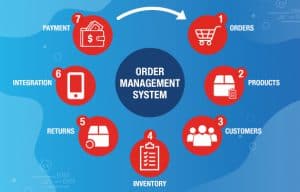Over the last few decades, the world of B2B eCommerce has experienced a massive boom.
However, setting up and operating a successful business-to-business eCommerce venture requires a lot more than just setting up a website and running marketing campaigns.
Today, convenience, simplicity, and flexibility are the biggest concerns for all B2B clients.
In this post, we’ll discuss the tri-spoke wheel that can drive any B2B eCommerce business forward. These three spokes (or areas) include:
- Automating client interactions
- Simplifying and Personalizing the core B2B eCommerce processes
- Offering flexible security
Let’s jump right in.
1. Automating Client Interactions
Using automation and business intelligence is one of the keys to increasing profitability.
In the context of B2B eCommerce, this boils down to the following two factors:
a) Providing the Ability to Import/Export Data in the Preferred Formats
Importing and exporting critical data (such as product details, prices, particulars, etc.) are two core components of an eCommerce business.
While this may not be applicable to all businesses, having a framework that allows your clients and strategic partners to upload or extract data in the formats of their choice can work wonders for the overall UX.
Here’s what it means (and how it’s relevant to automation):
- Clients – depending on the solution(s) you’re offering, your clients may want to extract or upload relevant data from/to your servers. A good example is allowing a customer to upload their order details to your portal instead of having to manually select items for their order.
- Partners – if you have a traditional supply chain where you acquire products from manufacturers, make sure that you’re forwarding and accepting data in their preferred formats.
Integrating a custom plugin that can safely convert data files into various formats in real-time can help.
b) Leveraging Tools for Automatic Data Collection
Another critical aspect of automation is to use the right stack to collect data.
Here’s a critical list that could make or break your B2B eCommerce business:
- Web Analytics – a tool that provides real-time information about your website’s visitors, such as the volume of traffic, bounce rates, conversions, and much more.
- Order Management System – an OMS is the primary component of any retail eCommerce. By integrating with your online POS, it will automate the collection, processing, and tracking of customer orders/transactions. Furthermore, a decent OMS will provide real-time reports about inventory.

- Feedback Collection Tool – you need a tool where your clients and partners can provide feedback. While most CRM software offers built-in feedback collection features, there are also stand-alone solutions out there.
2. Simplifying and Personalizing the Core B2B eCommerce Processes
Simplicity, coupled with personalization, can go a long way in fostering customer loyalty.
However, that’s easier said than done.
Here are some actionable eCommerce tips that you can apply in this context:
a) Use Customer-Specific Pricing
While some B2C brands are also embracing the concept, customer/client-specific pricing is more popular and effective in B2B.
Under this pricing strategy, all or some of the customers pay unique prices.
This pricing is based on the individual accounts of those customers, factoring in:
- Special Requirements – compared to B2C, B2B eCommerce involves a great level of personalization. Whether you’re selling products in bulk or offering a customizable solution (like a SaaS), you need to factor in the special requirements of your client while calculating a price quote.
- Lifetime Value (LTV) – how much revenue has the client brought in so far? Reward your high-value, loyal customers with special discounts and have them come back for more.
- Budget – consider how much the client is willing to pay to purchase your products/acquire your solutions. If it helps potentially capture a long-term client, consider making the compromise.
Note: Modern eCommerce plugins (such as WooCommerce) come with customer-specific pricing capabilities.
b) Offer Relevant Product Catalogs
To potentially increase the average order values, offer personalized product catalog recommendations to your clients.
These recommendations can be based on predefined rules linked to the user’s log-in credentials. Or dynamically present product options based on their browsing history.
You can send relevant product catalogs to your clients through your website, email marketing, or through social and display network ads.
c) Provide Marketing Support Materials
You can’t survive the grueling competition of B2B eCommerce without content marketing.
Simply put: B2B clients need your help marketing your products.
Create a seamless experience by providing access to your image library and other promotional materials all on your eCommerce site.
d) Using Simple Order Creation Tools
For bulk-ordering, you need to have features that simplify and fast-track the order creation process.
For instance, a client trying to purchase over a thousand different items wouldn’t want to go through the same process a consumer would.
A quick entry feature that allows clients to enter the SKUs and the quantities of the products they need is a must.
e) Flexible Payments
Finally, accept flexible payment methods to capture a larger chunk of the market.
With business clients, products are usually sold in bulk on credit.
This means that the clients will receive the products, but won’t have to pay the complete price upfront (and pay the amount due over a specified period of time).
There are special loans that you can take to offset the delay of payment and acquire working capital. You can pay off those loans as you receive the remaining amount from your clients.
Don’t just stop there – try to offer additional modes of payments to maximize the convenience for your audience.
3. Offering Flexible Security
Whether you’re talking B2C or B2B eCommerce, security is a top priority.
However, rigid policies can do more harm than good in terms of efficiency and ease.
To balance the security and freedom offered to your clients, consider the following:
a) Offer Role-Based Security
Role-based security is an approach that restricts certain information, features, and functionalities of a system from unauthorized users.

For your internal operations, leveraging role-based security can help protect your data, while not affecting the productivity of your team.
b) Allow Multiple Users Per Client
If you offer a special service (such as a SaaS), allow your clients to have multiple people access your platform.
In other words, allow multiple users to use your product from a single account.
You can go one step further and throw role-based security into the mix if it seems appropriate.
c) Create Customer Service Tools to Support Clients
Remember – it’s all about convenience.
To support the day-to-day interactions of your prospects/clients with your channels, make sure that you’re enabling them in the first place, including, but not limited to:
- Setting up new accounts
- Resetting passwords
- Self-registration (with proper validation)
d) Limit Access to Private Information
Last but not least, make sure that you limit access to sensitive information that could be the foundations of your competitive edge.
This includes things such as wholesale catalogs, trade secrets, intellectual property, etc.
Only share such information with verified clients.
Wrapping It Up
In the remainder of 2020 and beyond, the success of B2B eCommerce will largely depend on how much ease and flexibility is added to the operations.
By focusing on the three key areas discussed above, i.e., automation, flexibility and simplicity, and security, you can deliver positive user experience, attract more prospects, and ultimately, scale your eCommerce business.
Still Have Questions?
B2B eCommerce Q&A Webinar

